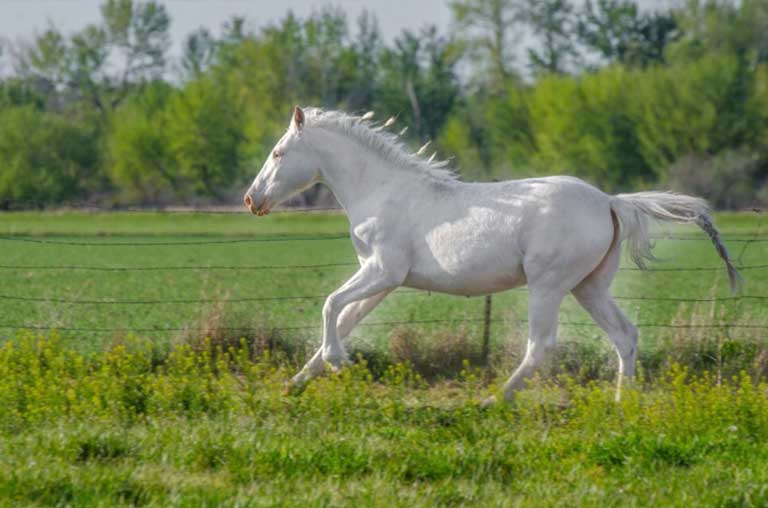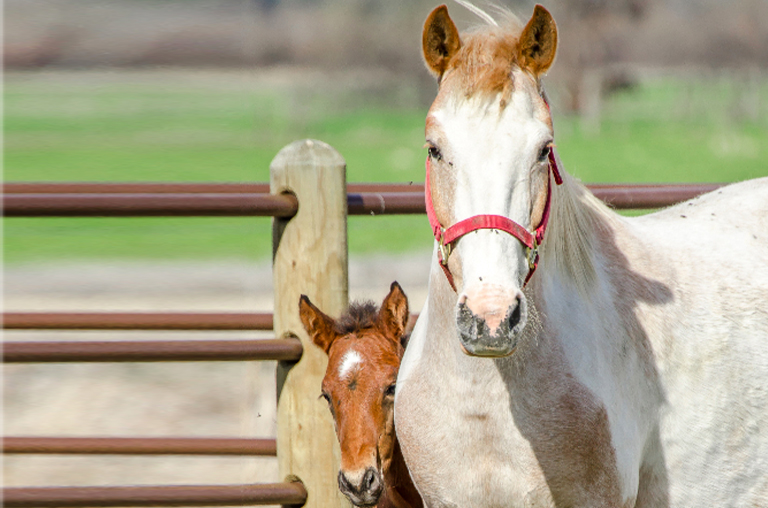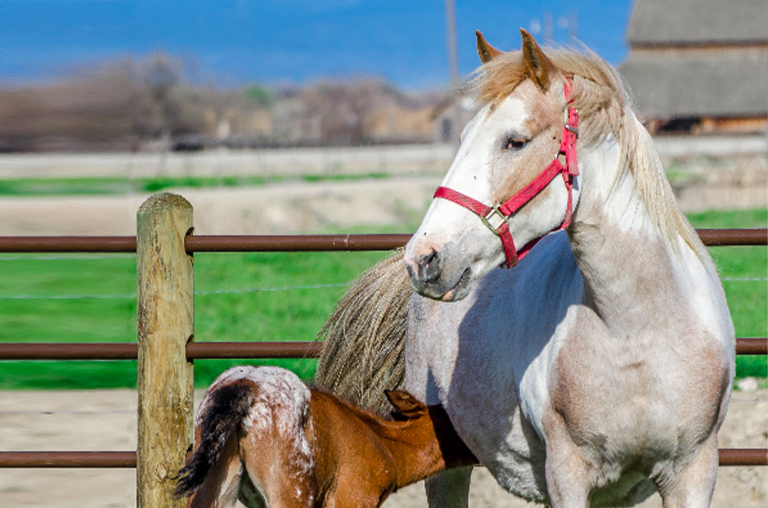What is a Quarter Horse?
The Quarter Horse breed or the American Quarter Horse is one of the oldest and most recognized breeds of horses in America. The origin of the Quarter Horse can be traced back to the 1600s as a cross between horses of native American horses of Spanish origin and English origin, which were imported to the American colonies by the Britishers. The quarter horse breed is known for its good temperament, speed, agility, and its ability to be a racehorse as well as a working ranch horse. They are friendly with people and easy to train, which makes them great mounts for all levels of riders. Some quarter horses have been recorded at a top speed of up to 55 mph or 88.5 kmph.
Quarter Horse Definition
A Quarter Horse can formally be described as a horse of a stocky and small breed known for its speed and agility over short ranges of distance. It is famously known for being the fastest breed over quarter-mile distances.
American Quarter Horse Origin
Where do Quarter Horses originate from?
In the 1600s, imported English Thoroughbred horses were first bred with assorted native horses on the Eastern seaboard of what is known today as the United States. One of the most famous Thoroughbreds of the earliest imports to be bred was Janus. The sire was imported to Virginia in 1756. By the late 17th century, these horses were successfully raced all over Rhode Island and Virginia in the quarter mile courses; hence, marking the origin of the Quarter Horse name. Other most influential sires included Steel Dust (born in 1843) and Peter McCue (born in 1895). The influence of genes from the Thoroughbreds resulted in the birth of horses that were small, hardy, and quick. They were used as workhorses during the week and race horses on the weekends.
In the 19th century, the colonial quarter horse was crossed with the western horses such as feral Mustangs and other domesticated breeds. This resulted in a new crossbred with an innate “cow sense”, a natural instinct to work with cattle, making it favorable for ranchers.
Development as a Distinct Breed

In 1940, a group of horsemen and ranchers from the Southwestern United States came together to form the American Quarter Horse Association (AQHA) in Fort Worth, Texas to preserve the pedigree of their Quarter Horses. The association today is dedicated to the preservation, improvement, and record-keeping of the registered Quarter Horse breed. It sanctions many competitions and maintains the official registry. It also houses the American Quarter Horse Hall of Fame and Museum and sponsors educational programs.
After the establishment of the official Quarter Horse Breed, the AQHA stud book remained open to add additional Thoroughbred blood on the basis of a performance standard. The first-generation cross between a registered Thoroughbred and an American Quarter Horse resulted in the “Appendix American Quarter Horse” breed. It was named so because the breed was entered into the appendix section of the AQHA stud book and was given entry to the permanent studbook only after meeting the eligibility criteria and competing in several AQHA sanctioned events. If the Appendix Horses gained entry, their offspring became eligible for AQHA registration.
Due to the continuous gene flow of the Thoroughbred breeds into the American Quarter Horse breed through Quarter Horse/Thoroughbred crosses, many characteristics of the typical breed that was formed in its early years have altered. Some Quarter Horse breeders argue that this addition is compromising the integrity of the breed standard. So, those who preferred earlier styles of horses have created separate organizations to promote and register Foundation Quarter Horses.
These are called real or original Quarter Horses. The organizations for Foundation Quarter Houses are Foundation Quarter Horse Association (FQHA) and National Foundation Quarter Horse Association (NFQHA). They require the horses to have more than 85% Foundation Quarter Horse blood. Some famous bloodlines include Oklahoma Star, Poco Bueno, Driftwood, Joe Hancock, Clabber, Bert, and many more.
Characteristics of American Quarter Horses

Quarter Horses range in size between 14 and 16 hands (56 inches and 64 inches). Although some halter types and English hunter types can grow up to 17 hands (68 inches). They come in almost all colors, but the most common in the breed is sorrel, a brownish red hue. Other colors include black, gray, brown, palomino, buckskin, dun, perlino, cremello, white, and so on. Some horses have spotted patterns, which are accepted by the AQHA registry if the owners can prove that the parents were both registered sire and dam.
The quarter horse breed has a compact and muscular structure. They are agile even at high speeds. They have a calm disposition, which makes them friendly with riders and cattle alike.
Types of Quarter Horses
Quarter Horses have three basic types, which are detailed in the following section.
Stock Type
A stock horse is well-suited to work with livestock, especially cattle. These are also used in competitions such as reining and cutting. These horses have a small stature and quick, agile movements with extremely powerful hindquarters.
Halter Type
Halter is a competition where horses are shown ‘in hand’, meaning that they are led instead of being ridden. They are judged based on the conformation and suitability of a breeding stock. Halter horses are larger with a heavily refined muscled appearance and retain their small heads with wide jowls.
Racing/Hunter Type
The racing type quarter horses are bred to sprint over short distances ranging from 220 to 780 yards. They are leaner than the stock-type horses and have long powerful legs and hindquarters. They compete against other quarter horses. The hunter type is slimmer and closer to a Thoroughbred. They participate in hunter/jumper classes at breed shows and other horse-show competitions.
Diet and Nutrition
American Quarter Horses need a balanced diet of water, minerals, carbohydrates, proteins, fats, and vitamins. Each individual horse should be regarded separately and provided with the required diet. It is important to consult a veterinarian while planning the diet for your horse. Also, the age of the horse, its activity level, and body condition score should all be considered. Mostly, a mix of hay and grains are fed to the horses, but they differ from region to region. Treats such as carrots and apples should be given in moderation.
Grooming

Since Quarter Horses are heavily used for showings and races, their grooming is an important part of their conformation. Owners must perform daily grooming sessions to catch any issues easily. Regular brushing of the coat, mane, and tails using a curry comb is important for a deep invigorating massage, loosening of dirt and debris, even distribution of natural oils as well as providing a natural sheen. It also encourages circulation in the stallion’s body. Use a soft-bristle brush for the legs and face. Use a damp sponge to clean near the eyes and nostrils. Clear out the hooves on a regular basis for the comfort of your horse. Pay special attention to areas such as inside the ears, under the belly, under the chin and jaw, tailbone and under the tail, front of the cannon bone, behind the pastern, and sheath (for geldings and stallions), and between the teats (mares).
Common Genetic Diseases
There are several genetic diseases that concern Quarter Horse breeders. Some of which are explained as follows:
Hyperkalemic Periodic Paralysis (HYPP)
It is a genetic disease that makes the horse suffer from muscle tremors, weakness, and eventual paralysis. This disorder affects the sodium channel in muscle cells and the ability to regulate potassium levels in the blood. It can affect the offspring even if only one parent can carry the gene because it is caused by an autosomal dominant gene. Since it is a genetic disease, breeders are advised not to breed the horses suffering from it.
Malignant Hyperthermia
This disease can occur in response to medications used during general anesthesia. Its symptoms include fast heart rate, muscle rigidity, and high fever. It is a good practice to have the horses tested before subjecting them to anesthesia.
Hereditary Equine Regional Derma Asthenia (HERDA)
This is caused by an autosomal recessive gene. This means, that to transfer this disease to the offspring, both parents need to carry the gene. This disease is a collagen defect, which results in the skin layers being loosely held. Due to this, any skin trauma can result in splitting of the skin from deeper layers or ripping off entirely. Horses that suffer from HERDA are euthanized to prevent them from being skinned alive.
Equine Polysaccharide Storage Myopathy (EPSM)

EPSM or PSSM is a metabolic muscular condition in horses, which results in glycogen storage disorder and tying up of muscles (muscle breakdown). This disease can somewhat be controlled through specialized low-starch diets. But breeders are advised to conduct genetic testing before breeding.
Cost of Owning an American Quarter Horse
It is crucial to consult with a professional horse trainer before purchasing a Quarter horse. The cost is highly variable due to the level of training, age, breeding, and health. On average, owners can spend between $3500 to $100,000 for a fully-trained American Quarter Horse. It is also advised to consider the cost of care, equipment, veterinary visits, food, etc. before making the purchase. Have a licensed vet do a pre-purchase examination to know about the health of your Quarter Horse.
Conclusion
It is safe to say that the American Quarter Horse breed is really versatile. The calm disposition and steady temperament of the horses make them a favorable option for beginners and families. Whether you want to use them for participating in shows and events or make them work on a ranch, or just need them for pleasurable trail rides and fun, these horses are a suitable choice. They are strong and fast, which makes them excellent for sports and showings. American Quarter Horses can compete in sprinting races, rodeos, ranch horse championships, AQHA events, and so on.
FAQs
Q1. Which two breeds make a Quarter Horse?
Ans. English Thoroughbred Horses bred with native American horses of Spanish origin resulted in the breed of the Quarter Horse.
Q2. What are the three types of Quarter Horses?
Ans. The three types of Quarter Horses are stock type, halter type, and racing/hunter type.
Q3. Is Quarter Horse a good breed?
Ans. Yes. The American Quarter Horse breed is a really versatile breed. These horses can be used as ranch workers for managing the livestock due to their innate cow sense. And they can also be used as show horses in various shows and events sanctioned by the American Quarter Horse Association. Their calm and steady temperament makes them a popular choice for families, beginner riders, and cowboys.
Q4. Why is it called a Quarter Horse?
Ans. These horses are fast, agile, and sure-footed. By the late 17th century, they were successfully raced over quarter-mile course ranges in Rhode Island and Virginia. That is how they got their name American Quarter Horses.
Q5. How much does a Quarter Horse cost?
Ans. An American Quarter Horse’s price can vary between $3000 to $100,000. It depends on the breeding, age, conformation, riding experience, competition experience, showing, and health condition of the horse.

Leave A Comment